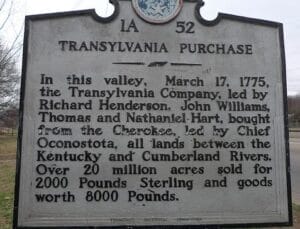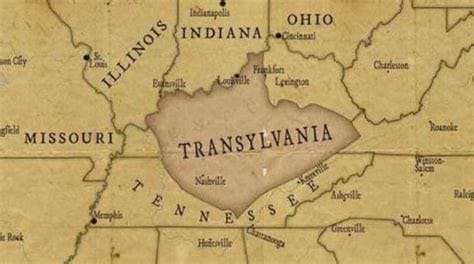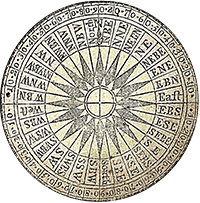The Royal Proclamation of 1763 that ended the French and Indian War declared lands west of the Appalachians as “Indian Territory”. The lands were forbidden to colonial settlement. However, because of colonial explorers, traders, and trappers, the Indians made additional concessions in exchange for peace.
In the 1768 Treaty of Fort Stanwix, the Iroquois ceded their claims on lands south of the Ohio River to the British Empire. Although they claimed sovereignty over of what is now Kentucky, the Iroquois did not actually reside there. No other tribes participated in the treaty.
The Iroquois, (and the Lenape and Shawnee who were then subordinate to them), and the “southern tribes” of the Cherokee and Catawba, had the shared hunting grounds of Kentucky for years.
A series of borders was worked out with the Cherokee at the Treaty of Hard Labour (1768), the Treaty of Lochaber (1770), and once more in 1771 when they agreed to extend the Lochaber cession into present-day northeast Kentucky.
The Shawnee, however, had not conducted a boundary agreement with the colonies since 1758 at the Treaty of Easton, which gave them a claim to everything west of the Alleghenies. They began to attack frontier settlers moving into the region. This led to Lord Dunmore’s War, fought in 1774, primarily between the Shawnee and Virginia Colony. The Shawnee lost this brief war and their chief Cornstalk ceded all their claims south of the Ohio River, including Kentucky.
In 1774, Richard Henderson, a judge from North Carolina, organized a land speculation company with a number of other prominent North Carolinians. The company became the Transylvania Company early in 1775.
The Transylvania Company investors hoped to establish a British colony by purchasing the Kentucky lands from the Cherokee who had earlier settled much of the south and southeastern Kentucky areas and still claimed hunting rights in the abandoned Shawnee lands.
In March 1775, Richard Henderson and Daniel Boone met with more than 1,200 Cherokee at Sycamore Shoals in northeastern Tennessee. Cherokee leaders such as Attakullakulla and Oconostota attended. Thru the Treaty of Sycamore Shoals, Henderson purchased all the land lying between the Cumberland River, the Cumberland Mountains, and the Kentucky River, and situated south of the Ohio River. Some adjacent land to the southeast, in Virginia and North Carolina, was also purchased. This purchase was about 20 million acres. Some Chiefs in attendance, such as Dragging Canoe, refused to sign endorse or obey the Treaty of Sycamore Shoals.
Henderson and his partners believed that a recent British legal opinion, the Pratt–Yorke opinion, had made such purchases legal. In fact, the Transylvania Company’s purchase was in violation of both Virginia and North Carolina law, as well as the Royal Proclamation of 1763, which prohibited private purchase of American Indian land and the establishment of any non-Crown sanctioned colony.
Prior to the signing of the Sycamore Shoals Treaty, Henderson had hired Daniel Boone, an experienced hunter, to travel to the Cherokee towns and to inform them of the upcoming negotiations. Afterward, Boone was hired to blaze what became known as the Wilderness Road, which went from southwestern Virginia north through the Cumberland Gap and into central Kentucky. with a party of about thirty workers, Boone cleared rough mud trail from the Cumberland Gap to what we know today as Boonesborough.
Historian Mildred Leedy Armao states that “Boone’s trace was simply a constellation of worn Indian footpaths and buffalo trails -marked and cleared of underbrush.” Unknown to Boone, Henderson led another expedition following in Boone’s tracks, widening the path so travelers could bring through wagons as far as Martin’s Station.
In addition to Boone’s Station, other settlements, including Harrod’s Town, Logan’s Fort, and Kenton’s Station, called Limestone, were established at this time. Many of these settlers had come to Kentucky on their own initiative, and some of them refused to recognize Transylvania’s authority.
There was just a sparse concentration of white settlers in the isolated western wilderness. When Henderson arrived at Boonesborough, fewer than a hundred people resided there. The settlers faced significant Indian hostilities, and lacked adequate supplies and shelter. Notwithstanding these circumstances, Henderson urged settlers in the area to hold a constitutional convention.
Henderson’s plan involved the settlements scattered across Transylvania sending delegates to Boonesborough, acting in the name of the people they represented and whose consent would justify the convention.
In May 1775, the convention met. Representatives from Harrod’s Town, Boiling Spring (adjacent to Harrod’s Town), Logan’s Fort and Boone’s Station attended. They passed bills dealing with immediate matters of governance and drafted a compact that organized a frame of government, known as the Transylvania Compact. This plan included executive, legislative, and judicial branches of government.
After concluding the compact, Henderson returned to North Carolina. On behalf of his fellow investors in the land scheme he petitioned the Continental Congress, seeking to make Transylvania a legally recognized colony. Congress declined to act without the consent of Virginia and North Carolina, both of whom claimed jurisdiction over the region in question.
In 1776, the Virginia General Assembly prohibited the Transylvania Land Company from making any demands on settlers in the region. In December 1778, Virginia’s Assembly then declared the Transylvania claim void. In compensation, Henderson and his partners received a grant of 200,000 acres on the Ohio River below the mouth of Green River. An early settlement there was named Red Banks, and became the city of Henderson in 1797.
Henderson pressed on with his claim in Tennessee, until it was invalidated by North Carolina in 1783. Henderson was also compensated there with a land grant of 200,000 acres in Powell Valley.
Sources:
Wikipedia
kentuckyancestors.org
legendsofamerica.com
Welcome to “Sharing the Stories of History with Tim Mann”!
Meet Timothy A. Mann, a passionate historian born and raised in the heart of Shelby County, Ohio where Tim’s roots run deep in the rich soil of American history. As the author of articles and books, including “Frontier Miscellany Concerning the Miami County Ohio Militia,” “Colonel John Mann, His Kith and Kin,” and “Frontier Militia – The War of 1812,” Tim’s literary contributions have enlightened and inspired countless history enthusiasts.
Join Tim Mann on a journey through time as he shares fascinating tales, untold stories, and hidden gems from the annals of history. Let’s delve into the past together and uncover the wonders that await in “Sharing the Stories of History with Tim Mann.






